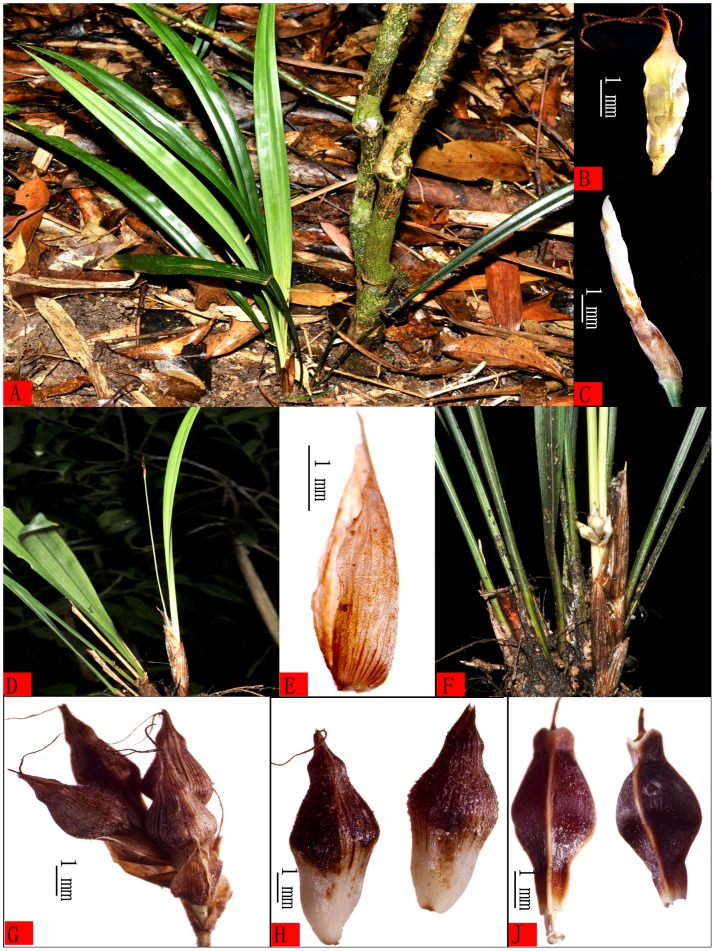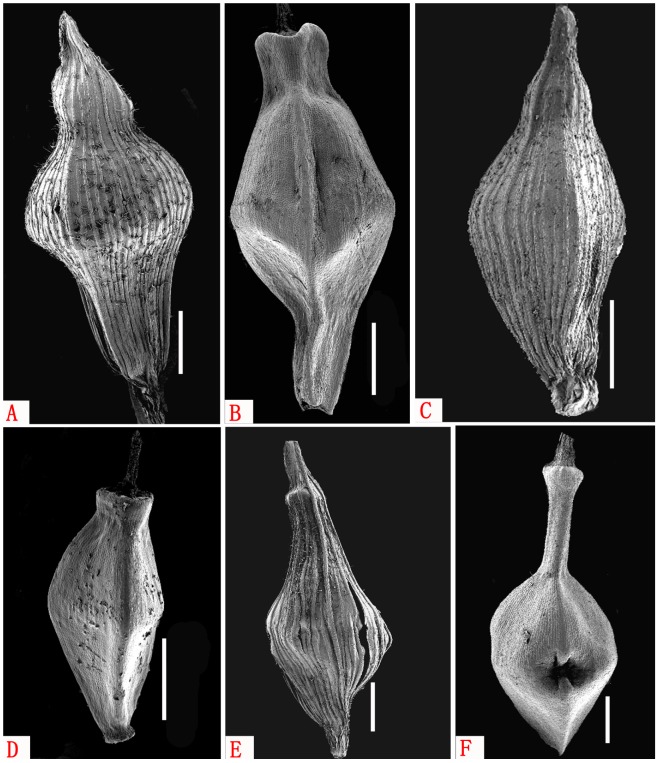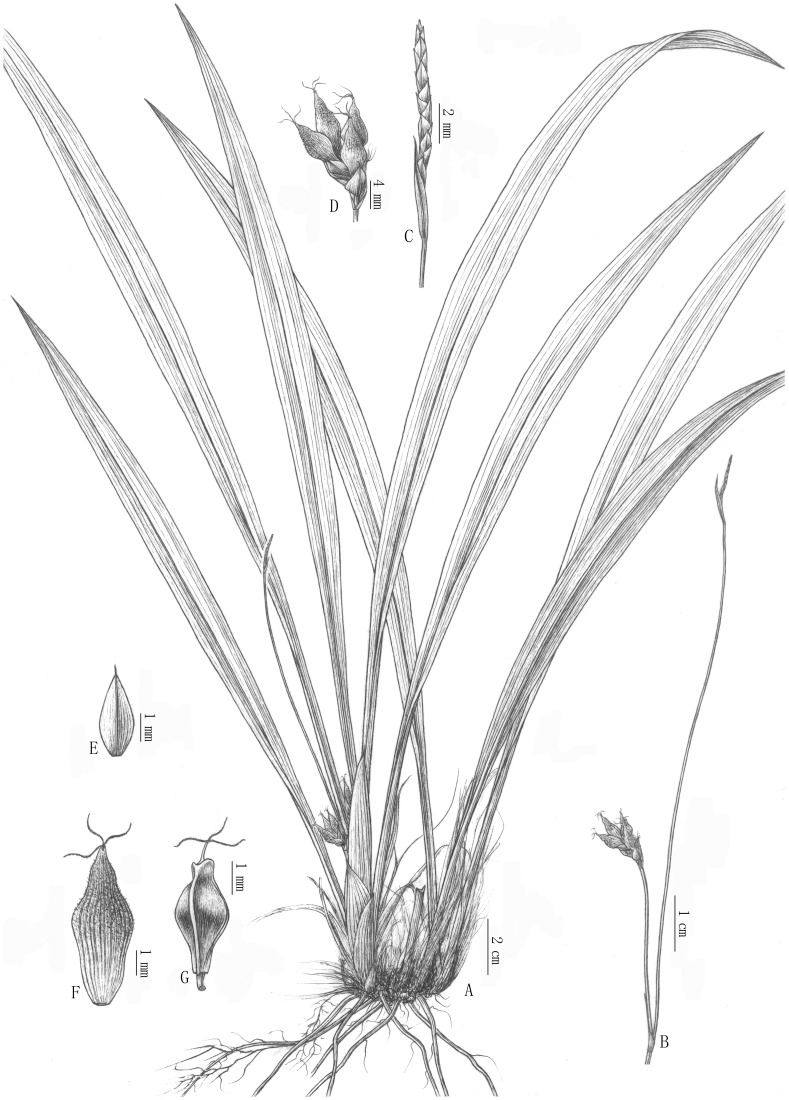Abstract
Carex diaoluoshanica, a new species of Carex sect. Lageniformes from Hainan, China, is described and illustrated. The new species is similar to C. breviscapa but differs in having wider leaves with the leaf base gradually narrowed, 5–10 cm long and petiolelike, culms subfiliform, with only two spikes, the lateral female spikes from near the culm base.
Introduction
The genus Carex was established by Carl Linnaeus Species Plantarum (1753). It is one of the largest genera of vascular plants, comprising about 2000 species distributed in various habitats, almost worldwide in distribution[1]–[4]. In China, it is represented by 527 species in three subgenera and 69 sections. Nine, additional species have been reported since publication of the Flora of China account[5]–[13].
The genus Carex is clearly distinguished from other genera of the Cyperaceae in having consistently unisexual flowers and a perigynium, the latter a sac-like structure of prophyllar origin that surrounds the naked gynoecium [14]. The variations in the structure of the perigynium are used as the key features in Carex. This is largely due to the subtle differences in shape, size, texture and nervation, which have been used as primary characters for the delimitation of many species in Carex [15]. Carex has been divided into subgenera in a number of ways based on the characters of stigma number, inflorescence structure and the distribution of staminate and pistillate flowers within the spikes. The most influential was Georg Kükenthal's classification which recognised four subgenera: Carex subg. Carex, C. subg. Indocarex, C. subg. Vignea and C. subg. Primocarex. Subsequently, C. subg. Indocarex and C. subg. Primocarex were corrected to C. subg. Vigneastra [16]. This classification was widely followed by most authors[3], [8], [17], [18], [22], [23].
Carex sect. Lageniformes (Ohwi) Nelmes belongs the core Carex clade[23]. It is characterized by having leaves longer than the culm, the terminal spike male and lateral spikes female, the female glumes oblong-ovate or obovate, the perigynium fusiform or rhombic-fusiform, the nutlet rhombic or fusiform with the apex truncate or shallowly concave, and the style base cylindric, slightly thickened, and persistent. It consists of 12 species mainly distributed in eastern and southeast Asia, with 8 species reported in China, 4 of which are endemic [3], [8]. Hainan Island is located at the southern part of China, at the northern edge of tropical Asia, with about 4100 vascular plants species [19]–[20]. To date, 24 species of Carex have been reported from Hainan Island [8], [13], [21].
Materials and Methods
Ethics statement
The new species reported in this work is collected from Diaoluo Shan Nature Reserve which is protected by the Forestry Bureau of Hainan. Permissions to visit location and field activities were obtained from Nature reserve management.
Morphological observations
Morphological description of the new species was based on examination of fresh and pressed specimens. Details of the terminal spike staminate, lateral spikes pistillate, pistillate glume, perigynium and nutlet were examined and photographed under a stereomicroscope (Olympus SZX16-6156). The Perigynium and Nutlet shape of Carex diaoluoshanica, C. breviscapa and C. longipetiolata were observed using a Philips XL-30E scanning electron microscope (SEM). The studied specimens are kept in the Herbarium of South China Botanical Garden, the Chinese Academy of Sciences (IBSC), and the Tropical Crops Genetic Resources Institute, Chinese Academy of Tropical Agricultural Sciences (TCGRI).
Nomenclatural Acts
The electronic version of this article in Portable Document Format (PDF) in a work with an ISSN or ISBN will represent a published work according to the International Code of Nomenclature for algae, fungi, and plants, and hence the new names contained in the electronic publication of a PLOS ONE article are effectively published under that Code from the electronic edition alone, so there is no longer any need to provide printed copies.
In addition, new names contained in this work have been submitted to IPNI, from where they will be made available to the Global Names Index. The IPNI LSIDs can be resolved and the associated information viewed through any standard web browser by appending the LSID contained in this publication to the prefix http://ipni.org/. The online version of this work is archived and available from the following digital repositories: PubMed Central, LOCKSS.
Results
During an investigation of the flora of Diaoluo Shan Nature Reserve in 2013, a new species belonging to Carex sect. Lageniformes was found (Fig. 1). This species is similar to C. breviscapa C. B. Clarke, but differs sufficiently to be recognized as a new species. Nine specimens (one holotype, four isotypes and four paratypes) of the studied are kept in the Herbarium of South China Botanical Garden, the Chinese Academy of Sciences (IBSC), and the Tropical Crops Genetic Resources Institute, Chinese Academy of Tropical Agricultural Sciences (TCGRI). Based on the shape of the perigynium and nutlet, the new species is most similar to Carex breviscapa, but they differ distinctly as follows (the former is new species, the latter is C. breviscapa): culms subfiliform, ca. 0.5 mm thick (culms slightly scabrid, ca. 2–5 mm thick); leaf blades 7–15 mm wide with the base attenuate and petiolelike, ca. 5–10 cm long (leaf blades 6–7 mm wide, not attenuate at base); inflorescence with just 2 spikes (inflorescence 3–5-noded, with 3–5 spikes at each node); lateral spikes 1–1.5 cm long (3–4 cm long), lateral female spike solitary, arising from near culms base and enclosed within bladeless sheaths (lateral female spikes many, arising from well above culm base).
Figure 1. Carex diaoluoshanica.
A. Habit. B. Stigmas. C. Terminal staminate spike. D. Inflorescence(pistillate spikes enclosed in bladeless sheaths). E. Pistillate glume. F. Flowering phase lateral pistillate spikes. G. Fruit period lateral pistillate spikes. H. Perigynium. J. Nutlet. Photographs by Hu-biao Yang.
Taxonomic treatment
Carex diaoluoshanica H. B. Yang, G. D. Liu & Q. L. Wang sp. nov.
[urn:lsid:ipni.org:names: 77137990-1] ( Figures 1 – 3 ). Type: —CHINA. Hainan: Lingshui County, Diaoluo Shan Nature Reserve, moist place under forest, alt. 800–900 m, 4 June 2013, Yang Hubiao 20130604017 (holotype, IBSC; one isotypes, IBSC; three isotypes, TCGRI).
Figure 3. Perigynium and Nutlet shape of Carex diaoluoshanica(A and B), C. breviscapa(C and D) and C. longipetiolata(E and F) viewed under SEM.
Scale bars = 1 mm.
Figure 2. Carex diaoluoshanica.
A. Hahit; B. Inflorescence; C. Terminal spike staminate; D. Lateral spikes pistillate; E. Pistillate glume; F. Perigynium; G. Nutlet. Drawn by Yu-xi Zhu based on Yang Hubiao 20130604017 (holotype TCGRI).
Description
Perennial; rhizome short, ligneous, covered with dark brown fibrous remains of old leaf sheath. Leaves basal, blade green, ensiform, 10–45×0.7–1.5 cm, flat, glabrous on both surfaces, apex acuminate, gradually narrowed into petiole-like base ca. 5–10 cm long. Culms solitary, arising centrally from leafy shoot, 9–20 cm tall, ca. 0.5 mm thick, subfiliform, trigonous, base clothed with bladeless brown sheaths. Inflorescence with 2 spikes; terminal spike male, narrowly cylindrical, 8–15 mm long, ca. 2 mm thick, sessile; lateral spikes female, peduncle arising from culm base, subfiliform 1–3 cm long, trigonous, enclosed in bladeless brown sheaths, spike cylindric, 10–15 mm long, loosely flowered. Male glumes oblong, ca. 3 mm long, brownish yellow; stamens 3, filaments shorter than the glumes; Female glumes pale yellow, obovate, ca. 4 mm long, membranous, hairless, many-veined, middle vein excurrent into a short awn ca. 0.5–0.8 mm long. Perigynium initially pale yellow, after maturity pale yellow below middle, brown above, longer than the glumes, fusiform, obscurely trigonous, ca. 7 mm long, minutely pubescent, many-veined, base cuneate, stipitate, apex gradually narrowed into a scabrous beak ca. 1–1.5 mm long, orifice straight, 2-toothed; stigmas 3. Nutlet brown to dark brown with angles and stipe yellowish white, tightly enveloped by the perigynium, fusiform, trigonous, 4–5 mm long, base stipitate, stipe 0.4–0.8 mm long, apex with distinct short neck ca. 0.5 mm long, neck obscurely trigonous, shallowly concave at apex; style base slightly thickened, persistent. Fl. and fr. May–July.
Distribution and Habitat
Carex diaoluoshanica is known only from Diaoluo Shan Nature Reserve, Hainan, China. It grows in a thick litter-fall layer with rich organic matter under the tropical mountain rain forest at altitudes of 800–900 m. The population, which comprises approximately 2 500 caespitose individuals, covers an area of 1 000 m2. Associates include trees of Altingia obovata Merrill & Chun, Cryptocarya maclurei Merrill, Dacrydium pectinatum de Laubenfels, D. imbricatus var. patulus de Laubenfels, Manglietia fordiana var. hainanensis (Dandy) N. H. Xia; and the shrub of Symplocos ovatilobata Nooteboom, Ardisia baotingensis C. M. Hu, Lasianthus chinensis (Champion ex Bentham) Bentham, Wendlandia uvariifolia Hance, Sterculia hainanensis Merrill & Chun; and the herbs of Hypolytrum nemorum (Vahl) Sprengel, Carex perakensis C. B. Clarke, Dianella ensifolia (Linnaeus) Redouté, Scleria terrestris (Linnaeus) Fassett, Ophiorrhiza cantonensis Hance.
Phenology
Flowering occurs from May and usually seeds maturity in June to July. Randomly collected 9 individual plants of the new species for morphological observations.
Etymology
The epithen “diaoluoshanica” refers to the type locality in Diaoluoshan Mountain Natural Reserve.
Additional Collections (paratypes)
CHINA. Hainan: Lingshui County, Diaoluo Shan Nature Reserve, moist place under forest, alt. 900 m, 21 June 2013, Yang Hubiao 20130621 (four paratypes, TCGRI).
Conservation status
The population of Carex diaoluoshanica comprises approximately 2 500 caespitose individuals, covers an area of 1 000 m2, at altitudes of 800–900 m. According to the IUCN (2001) category and criteria, C. diaoluoshanica is a vulnerable species(VU). Fortunately, this locality is in a remote place in the Diaoluoshan Natural Reserve.
Relationships
Carex sect. Lageniformes consists of 12 species mainly distributed in eastern and southeast Asia, such as C. breviscapa C. B. Clarke (China, Indonesia, Japan, Malaysia, Myanmar, Philippines, Thailand, Vietnam, and Australia); C. rhynchachaenium C. B. Clarke (China, Philippines and Vietnam); C. truncatigluma C. B. Clarke (China, Malaysia, Philippines and Vietnam); C. ascotreta C. B. Clarke ex Franchet (China, Japan and Korea); C. tenuispicula Tang ex S. Yun Liang, C. densipilosa C. Z. Zheng & X. F. Jin, C. ligata Boott ex Bentham and C. taihuensis S. W. Su & S. M. Xu (all endemic to China); C. yasuii Katsuy (endemic to Japan); C. palawanensis Kük. (endemic to Philippines); C. lageniformis Nelmes and C. pleurocaula Nelmes (all endemic to Thailand). The new species is placed in C. sect. Lageniformes because its perigynium and nutlet are fusiform, and cylindric, slightly thickened and persistent style base (Fig. 1, H and J; Fig. 3, A and B). But according to observation its differ from these above-mentioned, the main difference of morphological characters beweeen C. diaoluoshanica and its related species see the identification key. In Hainan Island, two members of this section, C. breviscapa and C. truncatigluma were recorded previously. The new species can be easily distinguished from these by the petiolelike leaf base 5–10 cm long, and the subfiliform culm with only 2 spikes. C. diaoluoshanica is most closely related to C. breviscapa by characters of the perigynium: longer than the female glumes, fusiform, obscurely trigonous, minutely pubescent, many-veined, and with the base cuneate and stipitate, but it differs from by the subfiliform culms, wider leafblade with a petiolelike base and by having only 1 lateral female spike inserted near the culm base. In addition, the species Carex longipetiolata Q.L. Wang, H.B. Yang & Y.F. Deng is also recorded from Diaoluo Shan Nature Reserve[13]. This is similar to C. diaoluoshanica because it also has a petiolelike leaf base. However, C. longipetiolata belongs to Carex sect. Rhomboidales Kükenthal and is characterized by the involucral bracts surpassing the inflorescence; the trigonous, rhombic to ovoid perigynia with columniform bidentate apical beaks, and by the elliptic-rhomboid, trigonous nutlets that are constricted in the middle part. According to the above characteristics C. longipetiolata and C. diaoluoshanica are clearly different (Fig.1; Fig. 3, A–B and E–F).
C. diaoluoshanica can be distinguishing from its related species by the following key.
Key to Carex diaoluoshanica and allies in section Lageniformes (Ohwi) Nelmes
-
1a
Nutlets constricted at middle on angles.
-
2a
Culms, leaves, and bracts glabrous; leaves 2–4 mm wide..........C. ascotreta
-
2b
Culms, leaves, and bracts pilose; leaves 4–12 mm wide..........C. densipilosa
-
1b
Nutlet not constricted on angles.
-
3a
Culms centra; lateral spikes female.
-
4a
Terminal spike androgynaeceous..........C. palawanensis
-
4b
Terminal spike male.
-
5a
Culms subfiliform, ca. 0.5 mm thick; leaves ensiform, base gradually narrowed into petiole-like structure..........C. diaoluoshanica
-
5b
Culms robust, 2–4 mm thick; leaves linear, base not petiole-like.
-
6a
Leaves as long as culms; perigynium glabrous..........C. yasuii
-
6b
Leaves far longer than culms; perigynium pubescent.
-
7a
Perigynium 3.5–5 mm; leaves 4–7 mm wide; culms 10–20 cm tall..........C. breviscapa
-
7b
Perigynium 5–6.5 mm; leaves 2–3 mm wide; culms 5–10 cm tall..........C. rhynchachaenium
-
3b
Culms axillary; lateral spikes female.
-
8a
Inflorescence equal to or longer than leaves.
-
9a
Male spikes linear, ca. 1 mm wide..........C. ligata
-
9b
Male spikes linear-cylindric, ca. 3 mm wide..........C. taihuensis
-
8b
Inflorescence shorter than leaves.
-
10a
Perigynium 2–3 mm..........C. tenuispicula
-
10b
Perigynium 3–6 mm.
-
11a
Inflorescence 0.7–1.2 cm long; lateral spikes 0.5–1 cm long; glume acute to obtuse at apex..........C. lageniformis
-
11b
Inflorescence 5–20 cm; lateral spikes 1.2–5 cm; glume usually with a short awn.
-
12a
All involucral bracts shorter than the extending spikelets..........C. truncatigluma
-
12b
Lower involucral bracts longer than the extending spikelets..........C. pleurocaula
Acknowledgments
We are grateful to Mr. Yu-xi Zhu for his help in preparing the line drawing.
Funding Statement
This research is supported by the basic scientific research fund of Tropical Crops Genetic Resources Institute (1630032014030); the earmarked fund for China Agriculture Research System (CARS-35-03) and Genetic Resource Conservation of Ministry of Agriculture (12RZZY-09). The funders had no role in study design, data collection and analysis, decision to publish, or preparation of the manuscript.
References
- 1. Ohwi J (1936) Cyperaceae Japonicae I. A synopsis of the Caricoideae of Japan, including the Kuriles, Saghalin, Korea and Formosa. Memoirs of the College of Science, Kyoto Imperial University (ser.B). 11: 229–530. [Google Scholar]
- 2. Nelmes E (1951) The genus Carex in Malaysia. Reinwardtia 1: 221–450. [Google Scholar]
- 3.Dai LK, Liang SY, Li PC, Tang YC (2000) Carex (Cyperaceae-Carioideae). In: Dai LK, Liang SY. (eds.) Flora Reipublicae Popularis Sinicae 12 . Science Press, Beijing, pp. 56–528. [Google Scholar]
- 4.David GF (2004) History and concepts of big plant genera. Taxon 3 : 753–776. [Google Scholar]
- 5. Jin XF, Zheng CZ, Ding BY (2004) New taxa of Carex (Cyperaceae) from Zhejiang, China. Acta Phytotaxonomica Sinica 42: 541–550. [Google Scholar]
- 6. Shimizu T (2008) Carex kagoshimensis, a new species of Carex (sect. Rhomboidales) from Japan. Acta Phytotaxonomica et Geobotanica 59: 67–72. [Google Scholar]
- 7. Jin XF, Zheng CZ (2010) Carex yandangshanica sp. nov. (Cyperaceae; C. sect. Rhomboidales) from Zhejiang, China. Nordic Journal Botany 28: 709–712. [Google Scholar]
- 8.Dai LK, Liang SY, Zhang SR, Tang YC, Koyama T, et al. (2010) Carex Linnaeus. In: Wu ZY, Raven PH, Hong DY. (eds.) Flora of China 23 . Science Press, Beijing &Missouri Botanical Garden Press, St. Louis, pp. 285–461. [Google Scholar]
- 9. Jin XF, Zhao YJ, Zheng CZ, Zhang HW (2011) Carex zhejiangensis sp. nov. (Cyperaceae) from Zhejiang, eastern China. Nordic Journal Botany 29: 63–70. [Google Scholar]
- 10. Jin SH, Zhao YJ, Shen TT, Wu DF, Jin XF (2012a) Carex tenuirostrata (Cyperaceae), a new species of section Confertiflorae from Zhejiang, China. Brittonia 64: 325–329. [Google Scholar]
- 11. Jin XF, Simpson DA, Zheng CZ, Sun L, Zhang HW (2012b) Carex paracheniana (Carex sect. Rhomboidales, Cyperaceae), a new species from Guangxi and Guizhou, China. Systematic Botany 37: 929–937. [Google Scholar]
- 12. Yu LY, Huang YF, Xu WB, Deng YF (2012) Carex trongii K. K. Nguyen, a newly recorded species of Cyperaceae from China. Journal of Tropical and Subtropical Botany 20: 403–406. [Google Scholar]
- 13. Wang QL, Yang HB, Deng YF, Wang ZN, Liu GD (2012) Carex longipetiolata (Cyperaceae), a new sedge from Hainan, China. Phytotaxa 75: 65–69. [Google Scholar]
- 14. Blaser HW (1944) Studies in the morphology of the Cyperaceae. I. Morphology of flowers. II. The prophyll. American Journal of Botany 31: 53–64. [Google Scholar]
- 15. Nelmes E (1951) The genus Carex in Malaysia. Reinwardtia 1: 221–450. [Google Scholar]
- 16.Kükenthal G (1909) Cyperaceae Caricoideae. In: Engler, A. (ed.) Das Pflanzenreich IV. 20 . Engelmann, Leipzig. 824 p. [Google Scholar]
- 17. Koyama T (1962) Classification of the family Cyperaceae (2). Journal of the Faculty of Science, University of Tokyo, Section III. Botany 8: 149–278. [Google Scholar]
- 18. Reznicek AA (1990) Evolution in sedges (Carex, Cyperaceae). Can. J. Bot 68: 1409–1432. [Google Scholar]
- 19. Liao WB, Jin JH, Wang B (2001) On island biogeography of Hainan Island's flora-Endemism and edge effect characteristics. Advances in Plant Science 4: 57–76. [Google Scholar]
- 20. Li S, Sun W, Li F, Lin P, Zheng Y, et al. (2005) Study on the characteristics and the cause of sandy desertified land in the west of Hainan Island. Acta Geographica Sinica 61: 433–442. [Google Scholar]
- 21.Liu GD, Bai CJ (2012) Cyperaceae of Hainan. Science Press, Beijing, 426 p. [Google Scholar]
- 22. Waterway MJ, Starr JR (2007) Phylogenetic relationships in tribe Cariceae (Cyperaceae) based on nested analyses of four molecular data sets. Aliso 23: 165–192. [Google Scholar]
- 23. Waterway MJ, Hoshino T, Masaki T (2009) Phylogeny, Species Richness, and Ecological Specialization in Cyperaceae Tribe Cariceae. The Botanical Review 75: 138–159. [Google Scholar]





